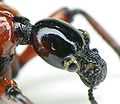Apoderus coryli
| Apoderus coryli | |
|---|---|
| | |
| Apoderus coryli, dorsal view | |
| Scientific classification | |
| Kingdom: | Animalia |
| Phylum: | Arthropoda |
| Class: | Insecta |
| Order: | Coleoptera |
| Superfamily: | Curculionoidea |
| Family: | Attelabidae |
| Subfamily: | Attelabinae |
| Genus: | Apoderus |
| Species: | A. coryli |
| Binomial name | |
| Apoderus coryli (Linnaeus 1758) | |
| Synonyms | |
| |
Apoderus coryli, common name Hazel-leaf Roller Weevil, is a species of leaf-rolling beetles belonging to the family Attelabidae subfamily Attelaninae. Because of the trunk-like elongated head, it is often mistakenly attributed to the weevils.
Description
Apoderus coryli can reach a length of 6–8 millimetres (0.24–0.31 in). These primitive weevils have a red shiny bell-shaped pronotum, a shiny black or dark brown head with protruding eyes, a distinct neck and short and rounded elytra. Their straight antennae are inserted near the base of the rostrum. The prothorax is much narrower than the base of the elytra on the abdomen. The scutellum is broad, triangular to trapezoidal and without stripes. The legs are red at the base, black towards the end. Adults can be found between May and September. They feed on leaves of the host plant, the hazel (Corylus avellana), hence the Latin name coryli of the species, meaning hazelnut. Only in exceptional cases other deciduous trees, such as alder and birch, are used as host plants.
Behavior
The female cuts slits into leaves, lays her yellowish eggs on them and rolls up these leaves into cigar-shaped cylinders or ‘cradles’ for the developing larvae, that will feed and pupate in these the leaf wraps. The time of oviposition may take several weeks. Several cylinders per day are produced. The adult beetles will emerge in the summer. There are two generations per year. The larvae of the second generation overwinter in said cylinders.
Distribution
This species is widespread in most of Europe, in the East Palearctic ecozone and in the Near East.
Habitat
Apoderus coryli prefers deciduous forests where the host plant occurs, parks and gardens.
Gallery
-

Close-up of the head
-

Apoderus coryli starting cut near leaf stalk
-

Starting rolling
-

Continuing rolling
-

Roll on ground
-

Egg
References
- G.A. Olivier: Entomologie, ou histoire naturelle des insectes, avec leurs caractères génériques et spécifiques, leur description, leur synonymie et leur figure enluminée Coléoptères. Tome second Paris 1790
- SAKURAI K Leaf size recognition and evaluation of some attelabid weevils. II: Apoderus Balteatus Behaviour vol 106 no 3-4 pp 300–317 1988
- D. V. Alford Pests of Fruit Crops: A Colour Handbook
- Fauna Europaea
- Invertebrated Online
- Nature Spot
| Wikispecies has information related to: Apoderus coryli |